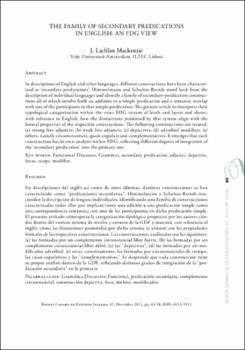The Family of Secondary Predications in English An FDG View
Autor
Mackenzie, J. LachlanFecha
2013Resumen
En descripciones del inglés así como de otros idiomas, distintas construcciones se han caracterizado como "predicaciones secundarias". Himmelmann y Schultze-Berndt trascienden la descripción de lenguas individuales, identificando una familia de construcciones caracterizadas todas ellas por implicar tanto una adición a una predicación simple como una correspondencia semántica con uno de los participantes en dicha predicación simple.
El presente artículo reinterpreta la categorización tipológica propuesta por los autores citados dentro del estricto sistema de niveles y estratos de la GDF y muestra, con referencia al inglés, cómo las distinciones permitidas por dicho sistema se alinean con las propiedades formales de las respectivas construcciones. Las construcciones analizadas son las siguientes:
(a) las formadas por un complemento circunstancial libre fuerte, (b) las formadas por un complemento circunstancial libre débil, (c) las 'depictivas', (d) las formadas por un modificador adverbial, (e) otras, concretamente, las formadas por circunstanciales de tiempo, las cuasi-copulativas y las "complementativas". Se desprende que cada construcción tiene su propio análisis dentro de la GDF, reflejando distintos grados de integración de la "predicación secundaria" en la primaria. In descriptions of English and other languages, different constructions have been characterized as 'secondary predications'. Himmelmann and Schultze-Berndt stand back from the description of individual languages and identify a family of secondary-predication constructions all of which involve both an addition to a simple predication and a semantic overlap with one of the participants in that simple predication. The present article re-interprets their typological categorization within the strict FDG system of levels and layers and shows, with reference to English, how the distinctions permitted by that system align with the formal properties of the respective constructions. The following constructions are treated:
(a) strong free adjuncts; (b) weak free adjuncts; (c) depictives; (d) adverbial modifiers; (e) others, namely circumstantials, quasi-copulars and complementatives. It emerges that each construction has its own analysis within FDG, reflecting different degrees of integration of the "secondary predication" into the primary one





